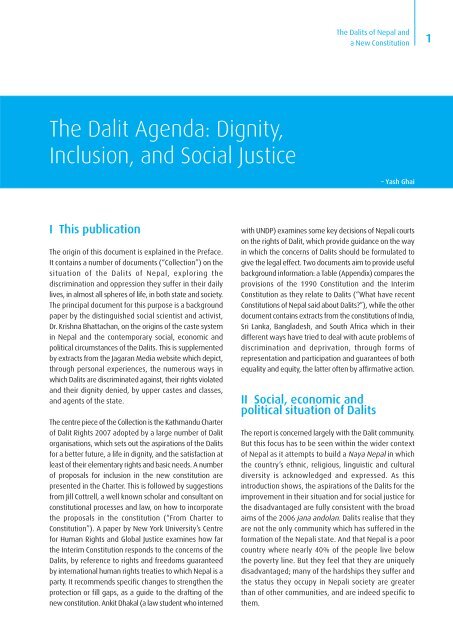The Dalits of Nepal and a New Constitution - ConstitutionNet
The Dalits of Nepal and a New Constitution - ConstitutionNet
The Dalits of Nepal and a New Constitution - ConstitutionNet
You also want an ePaper? Increase the reach of your titles
YUMPU automatically turns print PDFs into web optimized ePapers that Google loves.
<strong>The</strong> <strong>Dalits</strong> <strong>of</strong> <strong>Nepal</strong> <strong>and</strong><br />
a <strong>New</strong> <strong>Constitution</strong><br />
1<br />
<strong>The</strong> Dalit Agenda: Dignity,<br />
Inclusion, <strong>and</strong> Social Justice<br />
– Yash Ghai<br />
I This publication<br />
<strong>The</strong> origin <strong>of</strong> this document is explained in the Preface.<br />
It contains a number <strong>of</strong> documents (“Collection”) on the<br />
situation <strong>of</strong> the <strong>Dalits</strong> <strong>of</strong> <strong>Nepal</strong>, exploring the<br />
discrimination <strong>and</strong> oppression they suffer in their daily<br />
lives, in almost all spheres <strong>of</strong> life, in both state <strong>and</strong> society.<br />
<strong>The</strong> principal document for this purpose is a background<br />
paper by the distinguished social scientist <strong>and</strong> activist,<br />
Dr. Krishna Bhattachan, on the origins <strong>of</strong> the caste system<br />
in <strong>Nepal</strong> <strong>and</strong> the contemporary social, economic <strong>and</strong><br />
political circumstances <strong>of</strong> the <strong>Dalits</strong>. This is supplemented<br />
by extracts from the Jagaran Media website which depict,<br />
through personal experiences, the numerous ways in<br />
which <strong>Dalits</strong> are discriminated against, their rights violated<br />
<strong>and</strong> their dignity denied, by upper castes <strong>and</strong> classes,<br />
<strong>and</strong> agents <strong>of</strong> the state.<br />
<strong>The</strong> centre piece <strong>of</strong> the Collection is the Kathm<strong>and</strong>u Charter<br />
<strong>of</strong> Dalit Rights 2007 adopted by a large number <strong>of</strong> Dalit<br />
organisations, which sets out the aspirations <strong>of</strong> the <strong>Dalits</strong><br />
for a better future, a life in dignity, <strong>and</strong> the satisfaction at<br />
least <strong>of</strong> their elementary rights <strong>and</strong> basic needs. A number<br />
<strong>of</strong> proposals for inclusion in the new constitution are<br />
presented in the Charter. This is followed by suggestions<br />
from Jill Cottrell, a well known scholar <strong>and</strong> consultant on<br />
constitutional processes <strong>and</strong> law, on how to incorporate<br />
the proposals in the constitution (“From Charter to<br />
<strong>Constitution</strong>”). A paper by <strong>New</strong> York University’s Centre<br />
for Human Rights <strong>and</strong> Global Justice examines how far<br />
the Interim <strong>Constitution</strong> responds to the concerns <strong>of</strong> the<br />
<strong>Dalits</strong>, by reference to rights <strong>and</strong> freedoms guaranteed<br />
by international human rights treaties to which <strong>Nepal</strong> is a<br />
party. It recommends specific changes to strengthen the<br />
protection or fill gaps, as a guide to the drafting <strong>of</strong> the<br />
new constitution. Ankit Dhakal (a law student who interned<br />
with UNDP) examines some key decisions <strong>of</strong> <strong>Nepal</strong>i courts<br />
on the rights <strong>of</strong> Dalit, which provide guidance on the way<br />
in which the concerns <strong>of</strong> <strong>Dalits</strong> should be formulated to<br />
give the legal effect. Two documents aim to provide useful<br />
background information: a Table (Appendix) compares the<br />
provisions <strong>of</strong> the 1990 <strong>Constitution</strong> <strong>and</strong> the Interim<br />
<strong>Constitution</strong> as they relate to <strong>Dalits</strong> (“What have recent<br />
<strong>Constitution</strong>s <strong>of</strong> <strong>Nepal</strong> said about <strong>Dalits</strong>?”), while the other<br />
document contains extracts from the constitutions <strong>of</strong> India,<br />
Sri Lanka, Bangladesh, <strong>and</strong> South Africa which in their<br />
different ways have tried to deal with acute problems <strong>of</strong><br />
discrimination <strong>and</strong> deprivation, through forms <strong>of</strong><br />
representation <strong>and</strong> participation <strong>and</strong> guarantees <strong>of</strong> both<br />
equality <strong>and</strong> equity, the latter <strong>of</strong>ten by affirmative action.<br />
II Social, economic <strong>and</strong><br />
political situation <strong>of</strong> <strong>Dalits</strong><br />
<strong>The</strong> report is concerned largely with the Dalit community.<br />
But this focus has to be seen within the wider context<br />
<strong>of</strong> <strong>Nepal</strong> as it attempts to build a Naya <strong>Nepal</strong> in which<br />
the country’s ethnic, religious, linguistic <strong>and</strong> cultural<br />
diversity is acknowledged <strong>and</strong> expressed. As this<br />
introduction shows, the aspirations <strong>of</strong> the <strong>Dalits</strong> for the<br />
improvement in their situation <strong>and</strong> for social justice for<br />
the disadvantaged are fully consistent with the broad<br />
aims <strong>of</strong> the 2006 jana <strong>and</strong>olan. <strong>Dalits</strong> realise that they<br />
are not the only community which has suffered in the<br />
formation <strong>of</strong> the <strong>Nepal</strong>i state. And that <strong>Nepal</strong> is a poor<br />
country where nearly 40% <strong>of</strong> the people live below<br />
the poverty line. But they feel that they are uniquely<br />
disadvantaged; many <strong>of</strong> the hardships they suffer <strong>and</strong><br />
the status they occupy in <strong>Nepal</strong>i society are greater<br />
than <strong>of</strong> other communities, <strong>and</strong> are indeed specific to<br />
them.








![g]k fnsf blntx? / gofF ;+l jwfg](https://img.yumpu.com/49483602/1/184x260/gk-fnsf-blntx-goff-l-jwfg.jpg?quality=85)



![+ljwfg;ef, /fHosf]k'g](https://img.yumpu.com/41604075/1/184x260/-ljwfgef-fhosfkg.jpg?quality=85)




